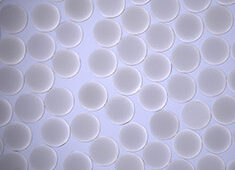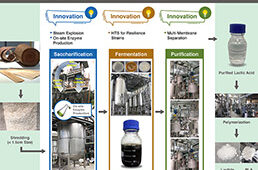Zinc oxide nanostructures are directly synthesized in parallel microfluidic channels (held by the metal frame) by flowing reactants through the tubing. The microfluidic structure not only creates the device, but also becomes the final packaged functional LED device itself. Photo: Jaebum Joo |
Researchers
at the Massachusetts Institute of Technology (MIT) have found a way to grow
submicroscopic wires in water with great precision, using a method that makes
it possible to produce entire electronic devices through a liquid-based
process.
The
team demonstrated the technique, called hydrothermal synthesis, by producing a
functional light-emitting diode (LED) array made of zinc oxide nanowires in a
microfluidic channel. They were able to do so on a lab bench under relatively
benign conditions: essentially using a syringe to push solution through a
capillary tube one-tenth of a millimeter wide, without expensive semiconductor
manufacturing processes and facilities.
Unlike
larger structures, with nanomaterials differences in shape can lead to dramatic
differences in behavior. “For nanostructures, there’s a coupling between the
geometry and the electrical and optical properties,” explains Brian Chow PhD ’08, coauthor of a paper describing the results Nature Materials. “Being
able to rationally tune the geometry is very powerful because you can, in turn,
tune the functional properties.” The system Chow and his colleagues developed
can precisely control the aspect ratio of the nanowires to produce anything
from flat plates to long, thin wires.
There
are other ways of making such nanowires, says Chow, who did this work as a
postdoc at MIT. “People have demonstrated good control over the morphology of
wires by other means, particularly at much higher temperatures or in organic
solvents. But to be able to do this in water under these low-temperature
conditions is attractive” because it may make it easier to manufacture such
devices on flexible polymers and plastics, he says.
Control
over the shapes of the wires has until now been largely a trial-and-error
process. “We were trying to find out what is the controlling factor,” explains
Jaebum Joo PhD ’10, now a senior research scientist at Dow Chemical Co., who
was the lead author of the paper.
The
key turns out to be the electrostatic properties of the zinc oxide material as
it grows from a solution, they found. The ions of different compounds, when
added to the solution, attach themselves electrostatically only to certain
parts of the wire—just to the sides, or just to the ends—inhibiting the wire’s
growth in those directions. The amount of inhibition depends on the specific
properties of the added compounds.
While
this work was done with zinc oxide nanowires, the MIT scientists believe the
method they developed for controlling the shape of the wires “can be expanded
to different material systems,” Joo says, perhaps including titanium dioxide,
which is being investigated for devices such as solar cells. Because the benign
assembly conditions allow the material to be grown on plastic surfaces, he
says, it might enable the development of flexible display panels, for example.
But
there are also many potential applications using the zinc oxide material
itself, including the production of batteries, sensors, and optical devices.
And the processing method has “the potential for large-scale manufacturing,”
Joo says.
The
team also hopes to be able to use the method to make “spatially complex devices
from the bottom up, out of biocompatible polymers,” Joo adds. These could be
used, for example, to make tiny devices that could be implanted in the brain to
provide high-resolution, long-term sensing and stimulation.





